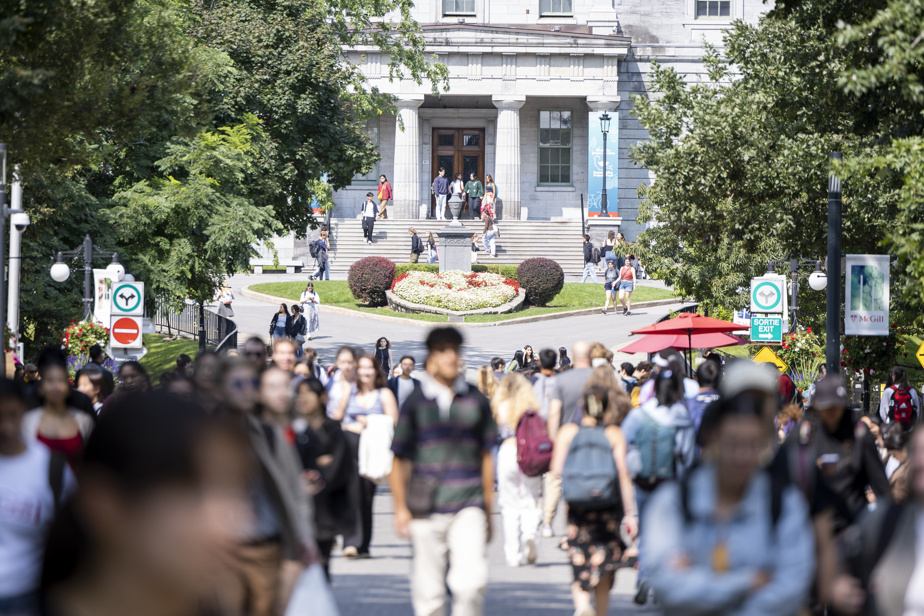For years, English-speaking universities have been the big winners in the battle between higher education establishments to recruit international students. But that’s changing.
The proportion of foreign students enrolled in Quebec’s English-speaking universities, which had grown steadily to reach a peak of 44.9% in the fall of 2020, has since fallen to 37.9% in the fall. 2022, noted The Pressbased on data compiled by the Office of Interuniversity Cooperation (BCI).

In total, in fall 2022, there were 54,321 international students, or 20,598 in the three English-speaking universities and 33,723 in the 16 French-speaking establishments.
The reversal of trend can be explained firstly by the fact that French-speaking universities have made efforts to attract more foreign students by organizing international recruitment campaigns, with the participation of the Quebec government, which have been crowned with success.
Last year, the number of foreign students jumped by 14% in French-speaking universities, compared to 4% in English-speaking ones.
These gains on the French-speaking side are reinforced by the fact that English-speaking establishments, which already have a high proportion of foreign students, are no longer seeking to increase their numbers as much. This is particularly the case of McGill, the university which welcomes the most in Quebec, but which does not want to increase its proportion of foreign students, currently 29%.
In French-speaking universities
At the University of Montreal (UdeM), international students represent 16% of the student body. There are more than 7,000 out of a total of 46,000 students.
“More than half come from France,” specifies the rector, Daniel Jutras.
“The other important basins are the countries of the Maghreb and French-speaking Africa,” he adds. There are still issues. Not Quebec issues, but federal immigration issues of delay in obtaining authorizations, which reduce our ability to convert offers of admission into registrations,” he declares, referring to the fact that African students have more difficulty obtaining study permits than those in other regions of the world, particularly in Quebec.
At HEC Montréal, affiliated with UdeM, the proportion of international students is also 16%. It climbs to 28% at Polytechnique Montréal, which is also part of UdeM. Together, UdeM, HEC and Polytechnique have 18% foreign students.
The University of Quebec in Montreal (UQAM), for its part, has 13% of students from elsewhere. Out of 35,000 people, nearly 5,000 come from outside Canada.
“This number has been growing for several years,” says spokesperson Caroline Tessier by email. “We are observing an increase of more than 15% in international students at UQAM between 2019 and 2022. Over a little more than 10 years, this growth is even more dazzling: there were 2,457 international students in 2010, and they are almost double in 2022.”
Throughout the Université du Québec (UQ) network, they are particularly numerous at the Université du Québec à Chicoutimi (UQAC) and at the École de Technologie Supérieure (ETS), where nearly one student in three (31%) come from abroad.
The highest percentage is at the National Institute of Scientific Research (INRS), a small university at UQ, dedicated to research and training of graduate students, with 63% international students.
At Laval University, foreigners represent 12%.
This proportion is 8% at the University of Sherbrooke, which has 2,000 international students out of a population of 25,000 students.
In English-speaking universities
Among English-speaking establishments, McGill welcomes the largest number of international students: nearly 11,000 out of 36,560 students, or 29% of its clientele. The three main countries of origin are China, the United States and France. Nearly half of McGill students are residents of Quebec and 23% come from other provinces.
It’s part of the university’s DNA to offer a multicultural experience to its students.
Fabrice Labeau, first associate executive vice-principal at McGill
McGill wants to maintain a percentage of international students between 25% and 30%, says Mr. Labeau. “We don’t want to go beyond that because we are a Quebec university and we want to keep this characteristic,” he explains. Our budgets are made based on that. »
Concordia also has a lot of foreign students: 9,300 out of 39,000 students, or 24% of the student body. The most represented countries are India, Iran, France, China and the United States. “In general, there are a higher proportion of international students at the graduate level,” says spokesperson Vannina Maestracci by email.
At Bishop’s, a small university of 3,000 students located in Estrie, international students represent 22% of the student body.
In the three English-speaking universities of Quebec, the third country of origin for international students is… France.
Learn more
-
- 17.4%
- Percentage of international students in Quebec universities, fall 2022
Source: Interuniversity Cooperation Office
- 20%
- Increase in international students enrolled in a master’s program in fall 2022, compared to the previous year
Source: Interuniversity Cooperation Office
